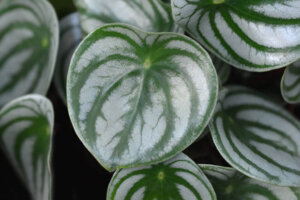Peperomia: A Beautiful and Easy-Care Plant

Peperomia is a popular houseplant for good reason! It’s beautiful and easy to care for, standing out for the color, shape, and design of its leaves. These have a red wine-colored base with detailed, light green lines.
Although there are other types of peperomia with smoother leaves and darker green in color, there are approximately 1,000 different varieties of this plant. Native to South America, Africa, and Asia, keep reading to learn more about this beautiful plant and its basic care.
Peperomia characteristics
Peperomia (Peperomia spp.) is an ornamental plant that, despite being native to tropical areas, adapts well to different environments. This is why it’s taken the crown as one of the easiest to care for ornamental plants.
Compared to other ornamental species, this one stands out for being small, but it has generous stems and leaves that stand out to the naked eye. Within the family of Piperaceae, we find some creeping, climbing, and even hanging plants.
Although its greatest attraction is its leaves, with their colors, and textures, this plant also blooms. From its interior sprouts an upright spike with tiny and grouped flowers that, despite not standing out much, are part of its appeal.

Basic care
We’re in no doubt that you’ve already fallen in love with peperomia and want to have one at home. Well, keep reading to find out how to take care of it.
1. Substrate and irrigation
The substrate for this plant must guarantee good water drainage, so it’s a good idea to add volcanic stone to the soil. This takes into account how peperomias store water in their leaves and fleshy stems. As such, avoid wet or waterlogged earth, which will exceed the capacity of the plant and end up damaging it completely.
These plants require watering between two and three times a week. In order not to exceed this or fall short, check the substrate. If it feels dry, it’s time to water it.
2. Peperomia: location and lighting
Being a tropical plant, peperomia needs to grow in a space where it receives a good amount of natural light each day. However, don’t place it in direct sunlight, otherwise, you’ll risk its beautiful leaves withering and burning.
You’ll know if it has insufficient light because its characteristic green color will fade and its stems will elongate. As soon as you identify that this is happening, find another location for your plant.
Moreover, the ideal location can be both indoors and outdoors. You choose the best place for your plant!
3. The higher the temperature, the greater the well-being
As a tropical plant, peperomia needs a warm environment to grow and develop properly. That ideal temperature is about 69.8 degrees Fahrenheit. You should increase watering during summer so that the plant feels more comfortable.
It must be said that warm seasons aren’t a problem for peperomia, but the cold is. Don’t allow the room temperature to drop to less than 55.4 degrees, as it’ll be at risk of dying.

4. Watch out for pests
Peperomia doesn’t require much care. However, if the basic isn’t provided, the plant can become sick and attract pests.
Equally, because it’s a fleshy and juicy plant, it’s susceptible to mealybugs, mites, and red spider mites. To get rid of these unwanted visitors, use an organic insecticide.
5. No pruning is required
This plant doesn’t require constant pruning, which is one less thing for you to worry about. The only thing you’ll need to do to maintain its well-being is to manually remove any dry and damaged leaves or stems.
Now, if the plant has become sick or the stems are elongated, cut away the affected branches. Moreover, if you want to grow and propagate peperomia, then take a small stem to serve as a cutting.
Enjoy your peperomia!
Now you know how to take care of your peperomia, don’t hesitate to buy one and enjoy its beauty in every corner of your home. This is a small plant, but it stands out for its beauty, so why not grow several different varieties?








